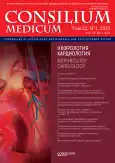Resistant arterial hypertension
- Authors: Rodionov A.V.1, Yudin I.G.1, Fomin V.V.1
-
Affiliations:
- Sechenov First Moscow State Medical University (Sechenov University)
- Issue: Vol 23, No 1 (2021)
- Pages: 28-31
- Section: Articles
- URL: https://journals.rcsi.science/2075-1753/article/view/95392
- DOI: https://doi.org/10.26442/20751753.2021.1.200697
- ID: 95392
Cite item
Full Text
Abstract
Full Text
##article.viewOnOriginalSite##About the authors
Anton V. Rodionov
Sechenov First Moscow State Medical University (Sechenov University)
Email: avrodion@mail.ru
канд. мед. наук, доц. каф. факультетской терапии Moscow, Russia
Ivan G. Yudin
Sechenov First Moscow State Medical University (Sechenov University)аспирант каф. факультетской терапии Moscow, Russia
Viktor V. Fomin
Sechenov First Moscow State Medical University (Sechenov University)чл.-кор. РАН, д-р мед. наук, проф., проректор по клинической работе и дополнительному профессиональному образованию, зав. каф. факультетской терапии Moscow, Russia
References
- Williams B, Mancia G, Spiering W, et al. 2018 practice guidelines for the management of arterial hypertension of the European society of cardiology and the European society of hypertension ESC/ESH task force for the management of arterial hypertension. Hypertension 2018; 36: 2284-309.
- Denolle T, Chamontin B, Doll G, et al. Management of resistant hypertension: Expert consensus statement from the French Society of Hypertension, an affiliate of the French Society of Cardiology. J Hum Hypertens 2016; 30 (11): 657-63.
- Sowers J, White W, Pitt B. The Effects of Cyclooxygenase-2 Inhibitors and Nonsteroidal Anti-inflammatory Therapy on 24-Hour Blood Pressure in Patients With Hypertension, Ostheoarthritis, and Type 2 Diabetes Mellitus. Arch Intern Med 2005; 165: 161-9.
- Karateev AE, Nasonov EL, Yakhno NN, et al. Clinical guidelines “Rational use of nonsteroidal antiinflammatory drugs (NSAIDs) in clinical practice". Mod Rheumatol J 2015; 1: 4.
- Combe B, Swergold G, McLay J, et al. Cardiovascular safety and gastrointestinal tolerability of eto-ricoxib vs diclofenac in a randomized controlled clinical trial (The MEDAL study). Rheumatology 2009; 48 (4): 425-32.
- Frohlich ED. Classification of resistant hypertension. Hypertension 1988; 11 (3): II.67-70.
- Gifford RW. An algorithm for the management of resistant hypertension. Hypertension 1988; 11 (3): II.101-5.
- Pedrosa RP, Drager LF, Gonzaga CC, et al. Obstructive sleep apnea: The most common secondary cause of hypertension associated with resistant hypertension. Hypertension 2011; 58 (5): 811-7.
- Calhoun DA, Jones D, Textor S, et al. Resistant hypertension: diagnosis, evaluation, and treatment: a scientific statement from the American Heart Association Professional Education Committee of the Council for High Blood Pressure Research. Circulation 2008; 117 (25): 510-26.
- Carey RM, Calhoun DA, Bakris GL, et al. Resistant hypertension: Detection, evaluation, and management a scientific statement from the American Heart Association. Hypertension 2018; 72: 53-90.
- Zamorano JL, Lancellotti P, Rodriguez Munoz D, et al. 2016 ESC Position Paper on cancer treatments and cardiovascular toxicity developed under the auspices of the ESC Committee for Practice Guidelines. Eur Heart J 2016; 37 (36): 2768-801.
- Acelajado MC, Hughes ZH, Oparil S, Calhoun DA. Treatment of Resistant and Refractory Hypertension. Circ Res 2019; 124 (7): 1061-70.
- Bobrie G, Frank M, Azizi M, et al. Sequential nephron blockade versus sequential renin-angiotensin system blockade in resistant hypertension: A prospective, randomized, open blinded endpoint study. J Hypertens 2012; 30 (8): 1656-64.
- Williams B, Macdonald TM, Morant S, et al. Spironolactone versus placebo, bisoprolol, and doxazosin to determine the optimal treatment for drug-resistant hypertension (PATHWAY-2): A randomised, double-blind, crossover trial. Lancet 2015; 386 (10008): 2059-68.
- Krieger EM, Drager LF, Giorgi DMA, et al. Spironolactone versus clonidine as a fourth-drug therapy for resistant hypertension the REHOT randomized study (Resistant Hypertension Optimal Treatment). Hypertension 2018; 71 (4): 681-90.
- Yugar-Toledo JC, Modolo R, de Faria AP, Moreno H. Managing resistant hypertension: Focus on mineralocorticoid-receptor antagonists. Vasc Health Risk Manag 2017; 13: 403-11.
- Oliveras A, Armario P, Clara A, et al. Spironolactone versus sympathetic renal denervation to treat true resistant hypertension: Results from the DENERVHTA study - A randomized controlled trial. J Hypertens 2016; 34 (9): 1863-71.
- Mahfoud F, Mancia G, Schmieder R, et al. Renal Denervation in High-Risk Patients With Hypertension. J Am Coll Cardiol 2020; 75 (23): 2879-88.
- Bates MC, Stone GW, Chen CY Spiering W. Device profile of the MobiusHD EVBA system for the treatment of resistant hypertension: overview of its mechanism of action, safety and efficacy. Expert Rev Med Devices 2020; 17 (7): 649-58. doi: 10.1080/17434440.2020.1779054
Supplementary files






